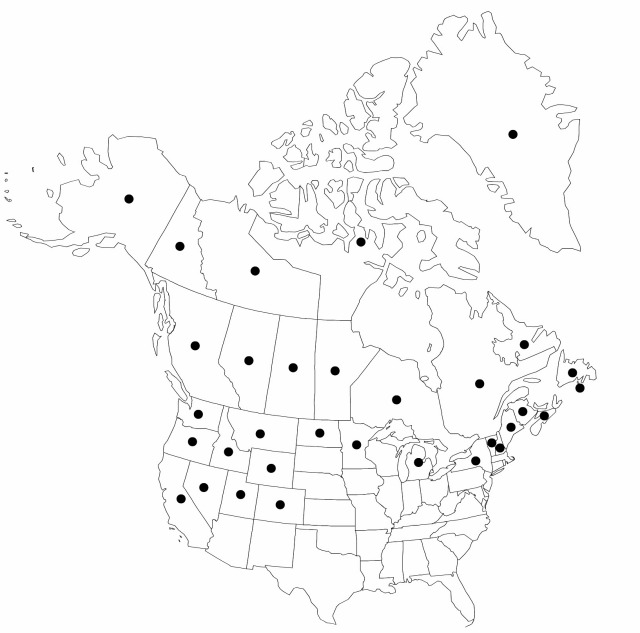Carex scirpoidea
Fl. Bor.-Amer. 2: 171. 1803.
Plants usually cespitose, short to long rhizomatous. Culms erect or lax, 5–35(–40) cm. Leaves: sheaths and bases from previous year’s leaves usually absent; ligules rounded or acute; blades glabrous adaxially. Inflorescences unispicate (very rarely with short, sessile lateral spike of same sex), mostly erect, ellipsoid; primary inflorescence bracts leaflike, rarely scalelike, shorter or longer than inflorescences. Scales red-brown to purple, ovate to lanceolate, to 3.5 × 1.5 mm, shorter than, equal to, or longer than perigynia, margins hyaline, narrow to broad, central midrib extending midway or to scale apex, apex acute to obtuse. Perigynia red-brown, ovate to lanceolate, to 4 × 1.6 mm, as wide as subtending scale, apex tapering or rounded, distal 3/4 hirsute with white hairs; beak 0.1 mm, orifice circular; rachilla absent. Achenes 1–2 × 0.6–1.2, tightly enveloped by perigynia, occupying full width and at least 3/4 length of perigynia. 2n = 62.
Distribution

Greenland, St. Pierre and Miquelon, Alta., B.C., Man., N.B., Nfld. and Labr., N.W.T., N.S., Nunavut, Ont., Que., Sask., Yukon, Alaska, Calif., Colo., Idaho, Maine, Mich., Minn., Mont., Nev., N.H., N.Y., N.Dak., Oreg., Utah, Vt., Wash., Wyo., Europe, Asia.
Discussion
Subspecies 4 (4 in the flora).
Subspecies of Carex scirpoidea grow in a variety of habitats in northern North America. Taxa previously recognized as varieties or separate species are treated here as subspecies of C. scirpoidea. Within the C. scirpoidea complex, all subspecies have the same chromosome number, possess similar achene micromorphology and leaf anatomy, interbreed in greenhouse experiments, and have morphologic characteristics that mostly fall within the normal range for C. scirpoidea.
Selected References
None.
Lower Taxa
Key
| 1 | Plants not cespitose; rhizomes long; sheaths and bases of previous year’s leaves persistent. | Carex scirpoidea subsp. pseudoscirpoidea |
| 1 | Plants cespitose; rhizomes short or inconspicuous; sheaths or bases of previous year’s leaves absent. | > 2 |
| 2 | Perigynia lanceolate, more than 2.5 times as long as wide; culms lax. | Carex scirpoidea subsp. stenochlaena |
| 2 | Perigynia ovate, less than or equal to 2.5 times as long as wide; culms erect. | > 3 |
| 3 | Widest leaves of pistillate culm more than 1.5 mm wide, widely V-shaped in cross section; North America, Europe, Asia. | Carex scirpoidea subsp. scirpoidea |
| 3 | Widest leaves of pistillate culm less than 1.5 mm wide, narrowly V-shaped in cross section; North America (restricted to shores near Lake Huron). | Carex scirpoidea subsp. convoluta |